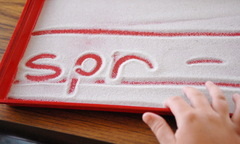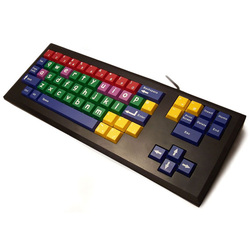What can I do to make my classroom dyslexia-friendly?
The first thing any teacher can do is be aware of dyslexia and related specific learning disabilities. In the United Kingdom there is a scheme for schools to become 'dyslexia-friendly'. This Information Pack developed by the British Dyslexia Association (BDA) provides some useful strategies for primary and secondary classrooms. The BDA describes a dyslexia-friendly school as one where the staff are proactively led to adopt flexible approaches:
“if children don’t learn the way we teach, we will teach them the way they learn”
The SAGE Handbook of Dyslexia (2008, p. 363) states that one important reason for schools to develop dyslexia-friendly practice is, that the strategies used have the potential to appeal to a wider group of students than just those with dyslexia.
The following tips and suggested accommodations for classrooms have been sourced from the British Dyslexia Association (BDA), Dyslexia-Teacher website and the Susan Barton training video, where possible links to useful resources have been included.
Ground rules:
- Make expectations high for intellectual stimulation but reasonable for written response.
- Enable dyslexic children to show their interest, knowledge and skills, despite their difficulties with writing. Often they will be able to ‘shine’ orally and should be encouraged to do this.
- Give guidance about how to tackle tasks systematically. Dyslexic children often need to be taught many things that other children pick up without specific adult help e.g. how to tidy a drawer; put their toys away; get dressed; look for something they have lost; pack their school bag; tie a tie or shoelaces. Recognise the importance of taking time to teach these skills in a systematic and repeated regular routine.
- Be prepared to explain things many times, in a variety of ways, individually.
- Correct only spellings they have been taught specifically and when you are looking at students' work, try to understand the reasons for the mistakes.
- Watch out for signs of tiredness – dyslexic students, have to work much harder than other students which is exhausting.
- Be slow, quiet and deliberate in your instruction giving, allowing time for the meaning of the words to ‘sink in’. Ensure they understand, by getting them to explain it back to you.
- Have resources clearly marked and neatly arranged so that they can be found easily.
- Make worksheets dyslexia-friendly.
Don't
- Don’t shout at dyslexic students when they lose or forget things, miss the meaning of something or have a ‘bad day’. Would you get annoyed with a deaf child who could not hear you?
- Don’t expect the same quantity of written work as you do from other students.
- Don’t ever mock or laugh at a dyslexic student for showing signs of dyslexia – and don’t allow others to ridicule them or call them ‘thick’.
- Don’t expect dyslexic students to copy from the board. Use the board for reminders, but not large pieces of work, if the board is used, provide a transcript for dyslexic students. The board could be divided into sections using different colours to ease place finding.
- Don’t overload dyslexic students with instructions.
-
Don’t
ask them to read aloud unless they are comfortable with the idea and have agreed to do so privately.
- Don’t make sudden changes in their timetable, teacher or task.
- Don’t
expect them to learn strings of facts by heart, e.g. multiplication
Teaching strategies:
- Use multi-sensory learning methods where possible. To see these methods in the classroom you can watch the following Orton-Gillingham promotional video and for more ideas look at the preview of the book Success with sight words: multi-sensory ways to teach high frequency words by Sara Throop.
- Use a structured and systematic way to teach spelling and phonemic awareness.
- Use flashcards which are linked in some way, for instance: opposites or words that have the same ending, like ‘me’, ‘we’, ‘be’ or ‘he’.
- Teach handwriting in very small groups or preferably one-to-one, using ‘continuous cursive handwriting’. This technique is particularly useful because the students pencil stays on the page throughout and so the motor-memory in their hand will help them memorise the order of the letters. Practise in sand and in the air.
- Use computers whenever possible to enhance specific aspects of teaching. Encourage the development of ICT skills. Speech to text software is available such as Key Stone Speech Master.
- Use the Internet, the following websites are a starting point:
www.ictgames.com
www.kidsmemory.com
www.playkidsgames.com
- Use other technologies such as audiobooks, to provide content at grade level which is too hard for dyslexic students to read: www.storynory.com Braille and Talking Book Library Service)
- Check that students are keeping up, and not just sitting passively, during shared reading and writing times. One idea is to give dyslexic students the books or text to be used in shared reading the week before, so that they can practise.
- Help dyslexic students understand the text they are reading. Comprehension can be a continuing problem for dyslexic people of all ages. Dyslexic students may be able to read a passage but get no meaning from it at all. Constant reference to the meaning of what they are reading is essential and should be practised frequently. Tips include reading each word or sentence twice; reading aloud, thinking or explaining the meaning of words or sentences as they read them or picturing what they have just read at full stops or commas.
- Allow students to complete an assignment in another form rather than being written.
Final points
Research suggests, a student with dyslexia is at risk from developing low-self esteem. Encourage your student with dyslexia and help them see the positives in their situation. Read about the positive traits of dyslexia on Living with Dyslexia. For further ideas, look at confidence building ideas.
Key Points
In order to provide an inclusive learning environment that is acceptable for students with dyslexia, teachers must be:
- flexible (i.e. adopt accommodations suggested by the British Dyslexia Association (BDA) )
- understanding of what it means to have dyslexia (IDA factsheet)
- aware of latest research and new understandings (IDA)
- systematic in teaching of spelling and reading
- prepared to use ICTs to enable students with dyslexia



